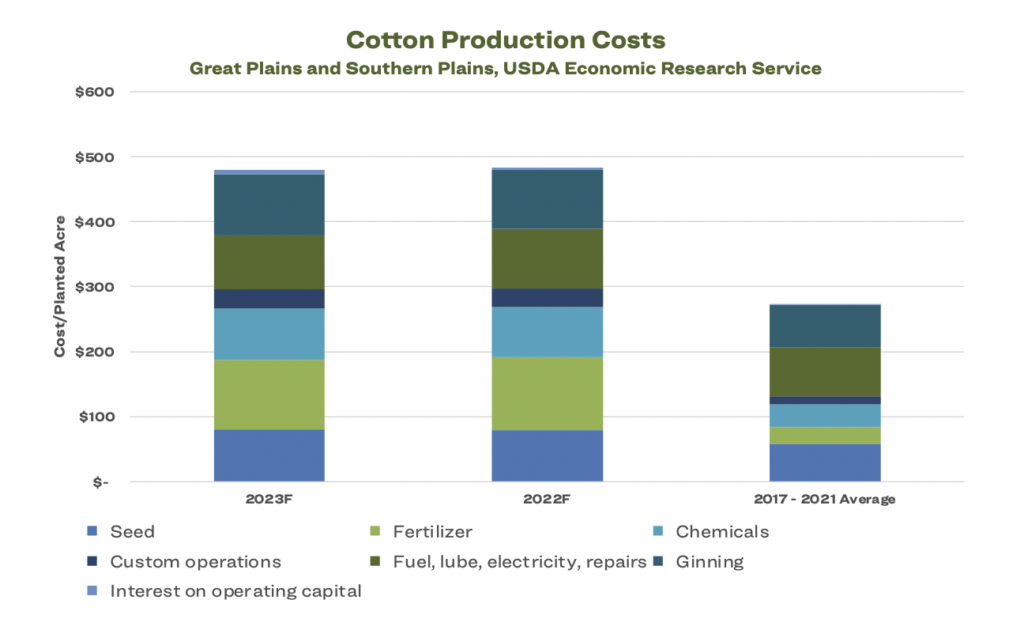by Aubry Heinrich
“Base hits win games.” The old baseball adage still rings true in more ways than one. The strategy is simple. The more base hits, the more opportunities your team will have to score.
 Farmers should be looking to get on base, not score the game-winning run with a grand slam of a bumper crop for 2023. Being efficient with resources will help sustain their operation to the next year and keep producers winning the game. Prices for all significant crop inputs have reached historically high levels, and they are here to stay, according to Justin Benavidez, Ph.D., Assistant Professor, and AgriLife Extension Economist.
Farmers should be looking to get on base, not score the game-winning run with a grand slam of a bumper crop for 2023. Being efficient with resources will help sustain their operation to the next year and keep producers winning the game. Prices for all significant crop inputs have reached historically high levels, and they are here to stay, according to Justin Benavidez, Ph.D., Assistant Professor, and AgriLife Extension Economist.
“Everything is more expensive. I don’t think it is a secret to anybody, farming and non-farming,” Benavidez said. “The big concern is that even though prices have gone up for most commodities, input prices are up as well. Input prices rose at a faster rate than the price of a lot of our commodities. So, that is really pressuring margins. Profitability is being stretched, even though our prices are really high.”
Inputs like fertilizer, fuel, and irrigation reached extraordinarily high rates in the 2022 crop year due to uncertainty, market volatility, and product availability. Unfortunately, farmers are still experiencing these after-effects and can expect to see them again in the 2023 crop year.
“Relatively, few people produce inputs,” Benavidez said. “The market structure of input production differs from commodity production. A lot of people produce cotton. So, we are looking at a perfectly competitive market for cotton producers versus a less competitive supply market. So, input prices tend to stay higher longer. They may not stay high forever, but historically input prices will stay high longer than our crop prices.”
Benavidez offers some advice for growers looking to mitigate these expenses and maximize their profitability.
“This is a year to spend time with your data,” he said. “You can’t manage what you don’t have data on. Spend time and know what is going on at the field level. You could be leaving money on the table if you mismanage input use, whether through overapplication or underapplication. It is not really an environment where we are going to try to push our inputs to make a bumper yield, but one where we use the fewest inputs possible to maintain normal yield,” Benavidez said. “It is important to sit down and look at what has worked for each field. Spend some money on testing. Where you can, do more tailored soil sampling. If you don’t know what parts of your fields need tailored fertilizer application, you are likely over-applying in some places and under-applying in others. That is not optimal. It is very likely an increased soil sampling survey will yield you more information, and that may save you dividends on that input application going forward.”
Producers need to know where to make efficient cuts to their input usage once the field data is collected. Some areas of an operation are more economically practical to cut back on without impacting yield and quality.
Benavidez points out that the price of each is a good place to start. For example, cutting 1% of fertilizer will count more than 1% of a cheaper input when allocating production dollars.
If producers go up to bat prepared to hit the ball out of the park, they will miss the knuckleball. Being intentional with resources and utilizing data to maintain yield and quality could be farmers’ key to winning the next crop year.
“It is a year to stay on base,” Benavidez said. “The more people you get on base over time, the higher the percentage you are going to win.”
Resources for growers to utilize their collected data and analyze the operation’s profitability:
- Texas A&M AgriLife Extension Crop Profitability Analyzers
- Lubbock.tamu.edu
Resources for producers looking to collect metrics on their farms:



